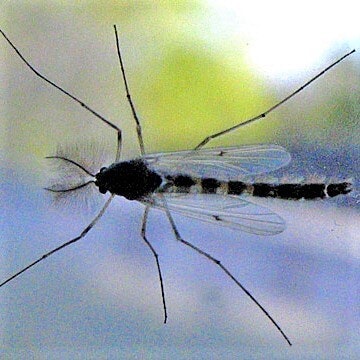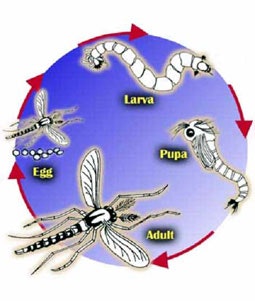Midges
.jpg?ixlib=rb-1.1.0&w=2000&h=2000&fit=max&or=0&s=7fb9d8fabcf348bdda20b55616da3bd1)
Midges are non-biting flies that resemble mosquitoes in size and general appearance. They are considered nuisances and are one of the vectors that are controlled by our specialized staff. Midges are approximately a half-inch in length and light green to brown in color. Midges are usually a problem from April to September and survive the winter as larvae in mud and at the water bottom. Swarms typically emerge at sunset.

Midges are especially bothersome for residents near flood control channels, ponds, reservoirs and spreading basins. Residents near these areas may find midges around cars, screen doors, windows, walls and entryways.
Impact on Living Standards
When midges emerge as adults in enormous numbers, they invade nearby residences, disrupting outdoor/indoor activities, causing the following problems:
- May create stressful living conditions for nearby residents by hampering outdoor activities such as jogging, barbequing, etc. around dusk.
- They are attracted to outdoor lights located approximately within a quarter mile of their breeding sources and may enter homes.
- Flying adults can become stuck on newly painted surfaces.
- Adults can deface walls, ceiling, curtains, and other property.
Health Problems Associated With Midges
Swarms can cause discomfort or irritation by entering the eyes, ears, nose, and mouth. These insects do not constitute a public health problem because they do not transmit diseases. Several species, however, have been documented as the cause of allergies in people exposed to massive swarms.
Economic Importance
In residential areas, they tend to lessen real estate value. In industrial situations, they interfere with processing of food, paper products, plastic, and automotive refinishing operations.
Life Cycle

These midges develop and breed in aquatic habitats similar to mosquitoes. Eggs are laid in a jelly-like mass on water or in the mud. Newly hatched from eggs, the larvae burrow into mud. The larvae are often bright red and live in water or wet soil, where they feed upon organic matter, particularly algae. The pupae rise to the water surface after the final larval stage and soon emerge as winged adults. Adults will live approximately 7 days depending upon the species and weather conditions. Males form swarms where they capture females for mating.
Is a midge a mosquito?
| Mosquito | Midge |
|---|---|
| 1. Uses proboscis to bite | 1. Cannot bite |
| 2. Wings are longer than its body | 2. Wings are shorter than its body |
| 3. Always develop in stagnant water | 3. Develop in mud on the bottom of lakes, ponds, etc. |
| 4. May carry diseases | 4. Does not carry diseases |
Tips To Help Alleviate Nuisance Midges
- Reduce overall electric light use in the evening by using less powerful bulbs
- Use yellow light bulbs in outdoor fixtures; yellow is less attractive to midges
- Delay turning lights on as long as possible after sunset.
- Keep doors closed and windows tightly screened to prevent midges from entering the home.
- Avoid using zap traps or other electrical traps, which are virtually ineffective.

.jpg?ixlib=rb-1.1.0&or=0&w=720&h=720&fit=max&auto=format%2Ccompress&s=b8ac9a724889754b4f64f4d9b08f23a3)
